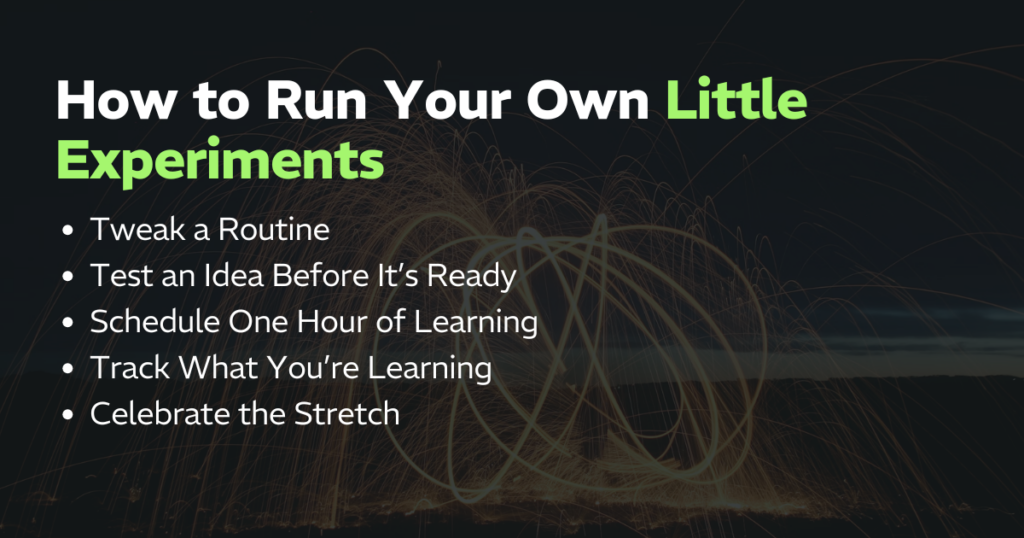Sustainable growth doesn’t happen in a single leap. It’s built in motion—through small, purposeful tests that push us just beyond what’s comfortable.
That’s what little experiments are for. They’ve become a core part of how I navigate change, challenge my assumptions, and keep learning, especially when the path ahead isn’t perfectly clear.
This isn’t about high-stakes bets or sweeping strategy shifts. It’s about something far more sustainable: making iteration a daily habit. Small experiments help us stretch without snapping. They create momentum, surface fresh insight, and drive the kind of adaptability that today’s environment demands.
Why Small Experiments Work
If the last few years have taught us anything, it’s this: waiting for the perfect moment is a losing strategy. The pace of change is relentless. Uncertainty is constant. And the most successful leaders aren’t the ones with perfect plans. They’re the ones who stay in motion. Little experiments offer a way forward.
They help you:
- Make decisions faster, with real-time feedback
- Test ideas safely and adjust quickly
- Build confidence and resilience, one rep at a time
- Stay sharp, curious, and ready for what’s next
And perhaps most importantly: they keep you learning. In a world where success is increasingly iterative, experimentation becomes an operating system for innovation.
How to Run Your Own Little Experiments
So how do you actually do it? How do you make experimentation part of your everyday rhythm instead of something you only talk about during strategic planning retreats?
You start small. You stay curious. And you treat motion as the goal.
These five practices are simple by design, but powerful in application. They’ll help you stay flexible, responsive, and in forward motion even when the future feels fuzzy.
Tweak a Routine
We are creatures of habit. That’s good for efficiency, but not always for growth.
Changing even one small thing about how you operate can rewire how you think and what you notice. Maybe it’s moving your creative work to the morning instead of cramming it in between meetings. Maybe it’s flipping the order of your team agenda. Or running a client check-in as a walk-and-talk.
Small disruptions spark fresh thinking. And that spark can lead to real breakthroughs.
Test an Idea Before It’s Ready
You don’t need a polished pitch to start sharing. And you don’t need to be 100% confident to act.
Run the experiment anyway. Float the concept. Ask the question. Bring the slide that’s only halfway built. Trying before you’re “ready” shortens the learning loop and teaches you what actually works in the real world, not just in your head. Give yourself permission to make mistakes.
Progress beats perfection. Every time.
Schedule One Hour of Learning
If it’s not on your calendar, it’s not real. One hour a week. That’s it. Make it count.
Use it to explore something unfamiliar: a podcast on customer psychology, a new sales enablement tool, a webinar you’d usually skip. Or use it to reflect and recalibrate.
Growth isn’t an event. It’s a rhythm.
Track What You’re Learning
A key part of any experiment is reflection. What happened? What surprised you? What did you learn? What would you change next time?
Writing it down turns motion into insight. It also builds your ability to connect dots, iterate faster, and communicate what you’re learning to others.
Feedback is fuel. Don’t skip this part.
Celebrate the Stretch
Not everything needs to be a win to be worth doing. In fact, one of the best things you can do for yourself and your team is to reward the effort, the courage, the creative risk.
Talk about what didn’t work. Share what you learned. Shine a light on the experiment that didn’t hit the mark but got everyone thinking differently.
When you reinforce the stretch, you reinforce the behavior. That’s how habits—and growth—stick.

Need Inspiration? Start With These Examples of Business Experiments
Sometimes the hardest part is knowing where to begin. If you’re looking for small, low-risk ways to test something new, try one of these.
Individual Experiments
- Run your next sales follow-up as a voice memo instead of an email.
- Replace your afternoon scroll with a 15-minute industry podcast.
- Ask one client a question you’ve never asked before.
- Block an hour for deep work before checking email.
Team Experiments
- Swap your Monday morning meeting for async updates.
- End each team huddle with a one-word check-in.
- Pilot a different feedback format (e.g., audio, video, or Loom).
- Rotate meeting facilitation among team members for one month.
These aren’t revolutionary moves. But they shift how we think, how we connect, and how we grow. That’s what makes them powerful.
A Challenge for You (and Your Team)
Little experiments are how we condition our “change readiness” muscle so that when disruption shows up (and it always does), we’re already in motion.
So here’s your challenge for the week: What three little experiments will you run right now? Write them down. Share them with your team. Take action on one of them today.
You don’t need perfect conditions. You just need to start.
Turn Small Steps Into Meaningful Change
If you’re ready to take your little experiments further and lead through uncertainty with clarity, download Leading Through Meaningful Change, our practical, strategic guide designed to help you navigate transition with confidence. Inside, you’ll find tools, prompts, and real-world insights to help you lead yourself (and others) through what’s next—one meaningful step at a time.







